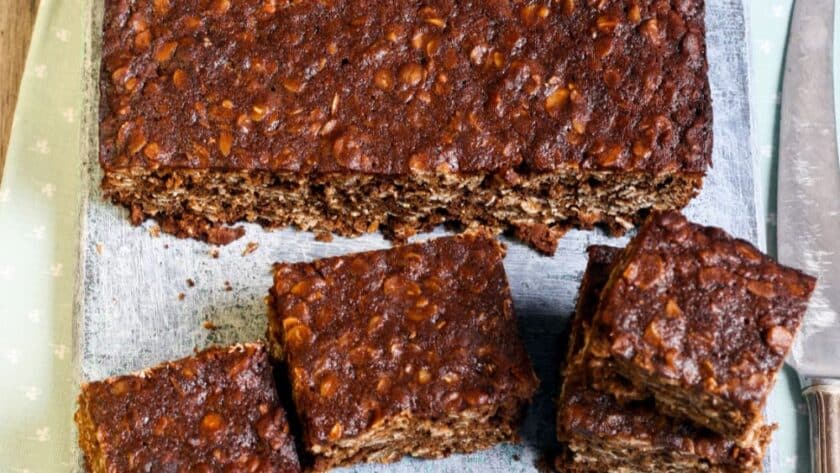Mary Berry’s Parkin recipe is one of the best and easiest UK Parkin recipes ever. For those unfamiliar with Parkin, it’s a ginger cake from Yorkshire.
This Traditional Parkin is made with oatmeal, ginger, golden syrup, treacle, light soft brown sugar, self-raising flour, and butter. This sticky Parkin is perfect with a cup of tea for afternoon tea.
If you want to make a Parkin recipe without oatmeal, simply use porridge oats instead of oatmeal, but make sure to grind them first to get the right consistency.
Please feel free to leave feedback about this old-fashioned oatmeal Parkin recipe from Mary Berry.
Parkin Ingredients
- 100g medium oatmeal
- 200g butter (plus extra for greasing)
- 1 large egg
- 4 tbsp milk
- 200g golden syrup
- 85g treacle
- 85g light soft brown sugar
- 250g self-raising flour
- 1 tbsp ground ginger
How To Make Parkin
- Preheat your oven to 160C (or 140C for fan ovens). Grease a 22cm square baking tin with butter and line it with baking paper.
- In a bowl, mix the egg and milk.
- In a big pot, melt the syrup, treacle, sugar, and butter. Make sure the sugar melts completely. Turn off the heat.
- In another bowl, mix the oatmeal, flour, and ginger. Add this mix to the pot.
- Add the egg and milk mix to the pot and stir everything well.
- Pour the batter into the baking tin.
- Bake in the oven for about 50 minutes to 1 hour. The cake should feel firm when touched.
- Let the cake cool inside the tin. After it cools, wrap it in baking paper and foil. For the best taste, wait up to five days before eating. The cake gets softer and stickier as days go by, and it’s good for up to two weeks.

What To Serve With Parkin
Traditionally, Parkin is served with hot tea, custard, or clotted cream. Parkin also goes well with vanilla ice cream, fresh berries, or a drizzle of caramel sauce.
Can I Use Porridge Oats Instead Of Oatmeal In Parkin
Yes, you can use porridge oats instead of oatmeal in Parkin, but make sure to grind the porridge oats to a finer consistency to mimic the texture of oatmeal.
How Long Does Parkin Last
Oatmeal Parkin lasts about two weeks in a cool, dry place. To keep Parkin right, wrap it in paper and then in foil after it’s cool.
Can You Freeze Parkin
Yes, Oatmeal Parkin can be frozen for about a month. To freeze Parkin correctly, ensure it’s fully cooled, then wrap it tightly in cling film or a freezer bag, ensuring all air is pushed out.
To thaw frozen Parkin, simply leave it out at room temperature for several hours or overnight, keeping it wrapped to retain moisture.
Parkin Nutrition Facts
- Calories: 248 kcal
- Fat: 11.4g
- Saturated Fat: 6.7g
- Carbohydrates: 33.3g
- Sugars: 18.5g
- Fiber: 0.9g
- Protein: 3g
- Salt: 0.5g
Try More Mary Berry Recipes:
- Lemon And Blueberry Cake
- Apple And Blackberry Crumble
- Apple And Sultana Cake
- Lemon Courgette Cake
- Pear Chutney
- Pineapple Upside Down Cake
Mary Berry Parkin
Description
Mary Berry’s Parkin recipe is one of the best and easiest UK Parkin recipes ever. For those unfamiliar with Parkin, it’s a ginger cake from Yorkshire.
This Traditional Parkin is made with oatmeal, ginger, golden syrup, treacle, light soft brown sugar, self-raising flour, and butter. This sticky Parkin is perfect with a cup of tea for afternoon tea.
If you want to make a Parkin recipe without oatmeal, simply use porridge oats instead of oatmeal, but make sure to grind them first to get the right consistency.
Mary Berry Parkin Ingredients
How To Make Mary Berry Parkin
- Preheat your oven to 160C (or 140C for fan ovens). Grease a 22cm square baking tin with butter and line it with baking paper.
- In a bowl, mix the egg and milk.
- In a big pot, melt the syrup, treacle, sugar, and butter. Make sure the sugar melts completely. Turn off the heat.
- In another bowl, mix the oatmeal, flour, and ginger. Add this mix to the pot.
- Add the egg and milk mix to the pot and stir everything well. Pour the batter into the baking tin.
- Bake in the oven for about 50 minutes to 1 hour. The cake should feel firm when touched.
- Let the cake cool inside the tin. After it cools, wrap it in baking paper and foil. For the best taste, wait up to five days before eating. The cake gets softer and stickier as days go by, and it’s good for up to two weeks.

